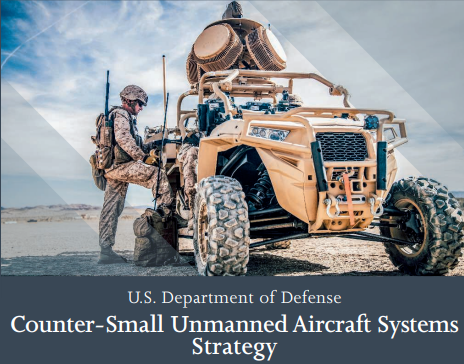US Department of Defense (DoD) has released a new document, the Counter-small Unmanned Aircraft Systems Strategy describing its strategy for small UAS.
Introducing the new publication, Tom Karako, Missile Defense Project Director of the DoD International Security Program said the security threat is no longer just about rogue state ballistic missiles but includes challenges across the spectrum.
The publication follows creation of the Joint C-sUAS Office (JCO) in 2019, which leads, synchronizes, and directs C-sUAS activities to facilitate unity of effort across the DoD.
To successfully address the sUAS challenge, the strategy lays out three strategic objectives:
- Enhance the Joint Force through innovation and collaboration to protect DoD personnel, assets, and facilities in the homeland, host nations, and contingency locations;
- Develop materiel and non-materiel solutions that facilitate the safe execution of DoD missions and deny adversaries the ability to impede our objectives; and
- Build and broaden our relationships with allies and partners to protect our interests at home and abroad.
Meeting these objectives will require emphasis on rapid innovation, synchronization of materiel and non-materiel solutions across the Joint Force, and partnerships that are underpinned by interoperability, integration, and information sharing.
According to the executive summary: “The strategy provides a framework for addressing sUAS across the spectrum from hazard to threat in the homeland, host nations, and contingency locations, and is expected to evolve in ongoing assessments. DoD stakeholders will work collaboratively to achieve three strategic objectives: (1) enhance the Joint Force through innovation and collaboration to protect DoD personnel, assets, and facilities in the homeland, host nations, and contingency locations; (2) develop materiel and non-materiel solutions that facilitate the safe and secure execution of DoD missions and deny adversaries the ability to impede our objectives; and (3) build and broaden our relationships with allies and partners to protect our interests at home and abroad.
“The DoD will address these objectives by focusing on three lines of effort: Ready the Force; Defend the Force; and Build the Team. To Ready the Force, DoD will maximize current C-sUAS capabilities and use a risk-based approach to guide efficient and rapid development of a suite of materiel and non-materiel solutions to address emerging requirements. To Defend the Force, DoD will coordinate the delivery of joint capabilities underpinned by DOTMLPF-P consideration and synchronize the development of operational concepts and doctrine. Finally, as the global military partner of choice, DoD will Build the Team by leveraging its existing relationships, create new partnerships, and expand information sharing to meet emerging challenges.
“Through the implementation of this strategy, the DoD will successfully address the challenges posed by both hazard and threat sUAS operating within the U.S. homeland, in host nations, and in contingency locations. Commanders in each of these varied operating environments will have the solutions they need to protect DoD personnel, facilities, assets, and missions from both current and future sUAS threats.”
For more information visit:




